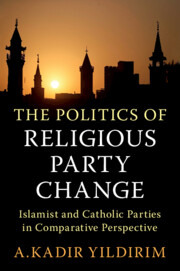Book contents
- The Politics of Religious Party Change
- Cambridge Studies in Social Theory, Religion, and Politics
- The Politics of Religious Party Change
- Copyright page
- Contents
- List of Figures
- List of Tables
- Acknowledgments
- Introduction
- 1 Explaining Religious Party Change
- 2 Catholic and Islamic Religious Institutions
- 3 Anticlericalism, Religious Revival, and the Rise of Religious Political Identities
- 4 The Origins of Religiopolitical Identity
- 5 Intraparty Conflict
- Conclusion
- Bibliography
- List of Interviews
- Index
Introduction
Published online by Cambridge University Press: 22 December 2022
- The Politics of Religious Party Change
- Cambridge Studies in Social Theory, Religion, and Politics
- The Politics of Religious Party Change
- Copyright page
- Contents
- List of Figures
- List of Tables
- Acknowledgments
- Introduction
- 1 Explaining Religious Party Change
- 2 Catholic and Islamic Religious Institutions
- 3 Anticlericalism, Religious Revival, and the Rise of Religious Political Identities
- 4 The Origins of Religiopolitical Identity
- 5 Intraparty Conflict
- Conclusion
- Bibliography
- List of Interviews
- Index
Summary
The Introduction sets the framework for the analysis and introduces the central research question of The Politics of Religious Party Change: when and why do religious parties become less anti-system? This chapter explains the significance of the question, discussing the rising prominence of religious parties globally and the need to better understand the dynamics of change in these parties. Likewise, the Introduction details the methodology used in this book and the six empirical cases: The Egyptian Muslim Brotherhood, Tunisian Ennahdha, Turkish AKP, German Center Party, Italian PPI, and Belgian Catholic Party.
Keywords
- Type
- Chapter
- Information
- The Politics of Religious Party ChangeIslamist and Catholic Parties in Comparative Perspective, pp. 1 - 20Publisher: Cambridge University PressPrint publication year: 2023

